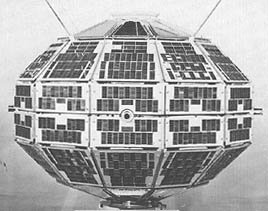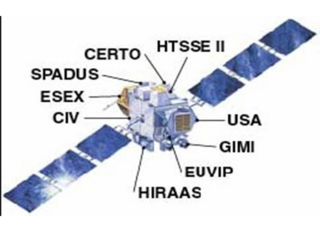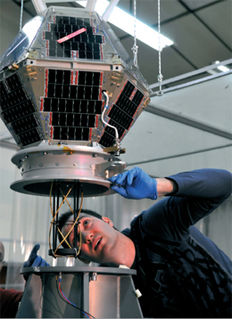
The Explorers program is a NASA exploration program that provides flight opportunities for physics, geophysics, heliophysics, and astrophysics investigations from space. Launched in 1958, Explorer 1 was the first spacecraft of the United States to achieve orbit. Over 90 space missions have been launched since. Starting with Explorer 6, it has been operated by NASA, with regular collaboration with a variety of other institutions, including many international partners.

Alouette 1 is a deactivated Canadian satellite that studied the ionosphere. Launched in 1962, it was Canada's first satellite, and the first satellite constructed by a country other than the Soviet Union or the United States. Canada was the fourth country to operate a satellite, as the British Ariel 1, constructed in the United States by NASA, preceded Alouette 1 by five months. The name "Alouette" came from the French for "skylark" and the French-Canadian folk song of the same name.

NOAA-4, also known as ITOS-G was a weather satellite operated by the National Oceanic and Atmospheric Administration (NOAA). It was part of a series of satellites called ITOS, or improved TIROS. NOAA-4 was launched on a Delta rocket on November 15, 1974. The launch carried two other satellites: AMSAT-OSCAR 7 and Intasat. It remained operational for 1463 days until it was deactivated by NOAA on November 18, 1978.

Ōsumi is the first Japanese satellite put into orbit. It was launched on February 11, 1970 at 04:25 UTC with a Lambda 4S-5 rocket from Uchinoura Space Center by Institute of Space and Aeronautical Science, University of Tokyo, now part of the Japan Aerospace Exploration Agency (JAXA). Japan became the fourth nation after the USSR, United States and France to release an artificial satellite into successful orbit on its own. The satellite is named after the Ōsumi Peninsula in Kagoshima Prefecture, Japan, where the launch site is located.

The Instituto Nacional de Técnica Aeroespacial «Esteban Terradas» is an autonomous agency of the Spanish public administration dependent on the Secretariat of State for Defence (SEDEF). It is responsible for the aerospace, aeronautics, hydrodynamics, and defense and security technologies research.
ISIS 1 and 2 were the third and fourth in a series of Canadian satellites launched to study the ionosphere over one complete solar cycle. After the success of Canada's Alouette 1, Canada and the United States jointly sent up three more satellites in the ISIS program. The first was named Alouette 2. As was the case for the Alouette satellites, RCA Ltd. of Montreal was the prime contractor for both ISIS 1 and 2.
The NASA Space Science Data Coordinated Archive (NSSDCA) serves as the permanent archive for NASA space science mission data. "Space science" includes astronomy and astrophysics, solar and space plasma physics, and planetary and lunar science. As the permanent archive, NSSDCA teams with NASA's discipline-specific space science "active archives" which provide access to data to researchers and, in some cases, to the general public. NSSDCA also serves as NASA's permanent archive for space physics mission data. It provides access to several geophysical models and to data from some non-NASA mission data. NSSDCA was called the National Space Science Data Center (NSSDC) prior to March 2015.
The Space Test Program (STP) is the primary provider of spaceflight for the United States Department of Defense (DoD) space science and technology community. STP is managed by a group within the Advanced Systems and Development Directorate, a directorate of the Space and Missile Systems Center of the United States Space Force. STP provides spaceflight via the International Space Station (ISS), piggybacks, secondary payloads and dedicated launch services.

The Advanced Research and Global Observation Satellite (ARGOS) was launched on 23 February 1999 carrying nine payloads for research and development missions by nine separate researchers. The mission terminated on 31 July 2003.
The Coherent Electromagnetic Radio Tomography (CERTO) is a radio beacon which measures ionospheric parameters in coordination with ground receivers. CERTO provides global ionospheric maps to aid prediction of radio wave scattering. CERTO was developed by the Naval Research Lab and is one of the 4 experiment packages aboard the PicoSAT satellite. CERTO provides near–real-time measurements of the ionosphere. CERTO was used for the Equatorial Vortex Experiment in 2013.
The Ionospheric Occultation Experiment (IOX) was a remote sensing satellite package that used a dual frequency Global Positioning System (GPS) receiver to measure properties of the ionosphere. IOX demonstrated remote sensing techniques for future United States Department of Defense space systems and helped to improve operational models for ionospheric and thermospheric forecasts.
The On-Orbit Mission Control will be conducted by the Surrey Satellite Technology Ltd ground site in Guildford, UK. The United States Air Force Academy at Colorado Springs, Colorado will operate a backup ground station for PicoSAT satellite to increase the amount of experimental data.
Kosmos 259, also known as DS-U2-I No.3, was a Soviet satellite which was launched in 1968 as part of the Dnepropetrovsk Sputnik programme. It was a 325-kilogram (717 lb) spacecraft, which was built by the Yuzhnoye Design Bureau, and was used to study the effects on radio waves of passing through the ionosphere.
Kosmos 378, also known as DS-U2-IP No.1, was a Soviet satellite which was launched in 1970 as part of the Dnepropetrovsk Sputnik programme. It was a 710-kilogram (1,570 lb) spacecraft, which was built by the Yuzhnoye Design Bureau, and was used to study the ionosphere.

The Nanosat-1B Spanish satellite, designed, developed and operated by the Instituto Nacional de Técnica Aeroespacial (INTA), is a nanosatellite which weighs 22 kg. Its main mission is the communication between remote sites like the Antarctic, the Hespérides warship and Spain. The Nanosat-1B has fourteen sides, all of them covered by solar cells but the bottom one where the following antennas are installed: a medium gain Ultra high frequency (UHF) four wire antenna and two patch antennas. On the top side there are four UHF monopoles. The solar sensors and the Vectorsol experiment are located in the middle tray, being all the other equipment and experiments located inside the satellite.

Robert Eugene Bourdeau was an American physicist known for major contributions to the study of the ionosphere, plasma physics and radio science using space vehicles including satellites and rockets. Among his many achievements was the launch on November 3, 1960 of Explorer 8 from Cape Canaveral, Florida. This occurred during his 16-year career at the National Aeronautics and Space Administration (NASA). He was both Project Manager and Project Scientist for Explorer 8 which added significant knowledge to the understanding of these fields.

The Nanosat 01, sometimes written as NanoSat-1 or NanoSat 01, was an artificial satellite developed by the Spanish Instituto Nacional de Técnica Aeroespacial (INTA) and launched the 18th of December 2004. Considered a nano satellite for its weight of less than 20 kg, its main mission was forwarding communications between far reaching points of the Earth such as Juan Carlos I Antarctic Base from mainland Spain. This was possible due to its polar orbit and altitude of 650 km above sea level. During an operational run the data obtained in the Antarctic would be uploaded to the satellite during its fly by and then, downloaded in Spain when satellite reached the Iberian Peninsula.
The INTA-100 vehicle was a small 2-stage meteorological sounding rocket designed and developed between the 1980s and the 1990s by the Instituto Nacional de Técnica Aeroespacial (INTA). The final design was entirely produced in Spain to be used by the Instituto Nacional de Meteorología in conducting experiments on the atmosphere.

OPTOS was a Spanish nanosatellite designed and developed by INTA with support from the European Cooperation for Space Standardization (ECSS) as a low-cost technology demonstrator. It was launched in 2013 and had a service life of 3 years.

STARAD was a radiation-monitoring satellite used to track the artificial radiation belt created by the Starfish Prime high-altitude nuclear test.











